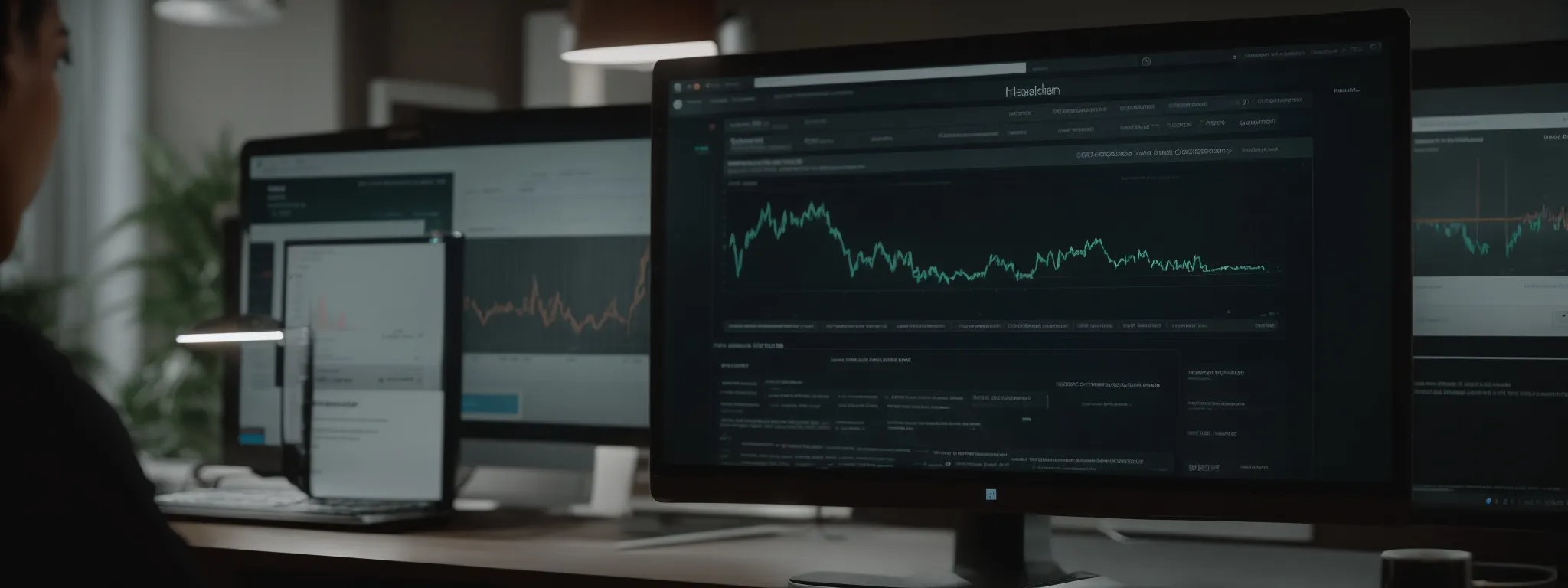Domain Strategy: Critical Component to SEO Technical Audits
Incorporating Domain Strategy Into Your SEO Technical Audits for Better Results Navigating the complexities of Search Engine Optimization requires diligent attention to various components, among which domain […]
Incorporating Domain Strategy Into Your SEO Technical Audits for Better Results
Navigating the complexities of Search Engine Optimization requires diligent attention to various components, among which domain strategy holds a pivotal position.
A thorough SEO audit that scrutinizes domain health, configuration, and renewal practices can uncover hidden opportunities to amplify a website’s search performance.
LinkGraph’s SEO services emphasize the importance of incorporating a robust domain strategy within technical audits to ensure that domain authority aligns with the broader SEO campaign objectives.
By leveraging LinkGraph’s comprehensive understanding of domain-related SEO factors, businesses can create a cohesive framework that supports enduring online visibility.
Keep reading to unlock the potential that a refined domain strategy can add to your SEO endeavors.
Key Takeaways
- Domain Strategy Plays a Vital Role in a Website’s Search Engine Ranking and Visibility
- LinkGraph Emphasizes the Importance of Domain Authority and Advises on Strategic Configurations for Maximum SEO Benefit
- Strategic Renewal and Domain Longevity Impact a Site’s Credibility and Authority in Search Engine Perceptions
- Proper Use of Redirects, Such as 301s and 302s, Is Crucial in Maintaining SEO Value During Domain Transitions
- LinkGraph’s SEO Services Include Meticulous Domain Setup and Configuration to Enhance Site Crawlability and User Experience
Understanding the Role of Domain Strategy in SEO Audits

In the intricate tapestry of search engine optimization, domain strategy emerges as a critical thread, subtly influencing a website’s standing in the digital hierarchy.
An efficient SEO technical audit should extend beyond mere on-page elements and off-page tactics, diving deep into the realm of domain analysis.
This includes scrutinizing the impact of the domain name on SEO, understanding how the length of domain registration might sway search rankings, and unearthing strategic insights from the domain’s historical data.
Such a comprehensive approach can unearth pivotal factors that either bolster or hinder a site’s ability to rank optimally in search results.
Addressing these domain-related variables is essential for companies like LinkGraph, whose expertise in SEO services ensures that every nuance of a client’s digital presence is meticulously examined for maximum search performance.
Identifying the Impact of Domain Name on SEO
The domain name, serving as a foundational component of a website’s identity, holds considerable sway over its SEO performance. It acts as a beacon for search engine crawlers, enabling them to discern the relevancy and context of a web page relative to user queries.
Experts at LinkGraph underscore the significance of a domain’s alignment with target keywords, which can directly influence its prominence in Google search results. This is why a deliberate domain strategy is a key discussion point during an SEO technical audit, ensuring that the chosen domain resonates with the brand’s core message and audience’s search intent.
How Domain Registration Length Influences Search Rankings
Search engines like Google consider a variety of SEO factors when determining the authority and credibility of a website, and the duration of domain registration can subtly weigh in this equation. A domain booked for a longer period signals stability and commitment to search bots, which may translate into a slight ranking advantage due to perceived trustworthiness.
In their rigorous approach to a client’s SEO campaign, LinkGraph’s team of SEO experts acknowledges that extended domain registration, while not a panacea, serves as a positive indicator to search engines, potentially aiding a website’s longevity and success in search result pages.
Assessing the Historical Domain Data for SEO Insights
Historical domain data offers a wealth of insights for SEO professionals, bringing to light previous website configurations, past ownership, and even sanctions that might have been imposed by search engines. LinkGraph harnesses such data during SEO audits, analyzing patterns that may reveal opportunities for content optimization or shed light on previous SEO issues that could impact current performance.
Deciphering the historical data associated with a domain serves as a form of digital archaeology, uncovering the narrative of a domain’s evolution over time. The findings of this exploration help LinkGraph’s SEO services craft a forward-looking strategy that is cognizant of the past yet focused on future search performance:
- Analysis of the backlink profile over different periods to detect changes and trends.
- Evaluation of content quality shifts and their correlation with search engine rankings.
- Review of domain registration timelines to inform the broader user experience strategy.
Unveiling the Potential of Domain Authority in Technical Audits

In the convoluted landscape of search engine optimization, domain authority presents itself as a telling gauge of a website’s influence and quality.
By scrutinizing domain authority during SEO technical audits, experts can glean insights into how well a site may perform against the relentless tide of competition in search engine results pages (SERPs).
The seasoned team at LinkGraph meticulously evaluates this metric, considering its potency in benchmarking a site against competitors and devising long-term strategies to elevate a site’s prominence in the digital realm.
This foresight is pivotal, as it sets the stage for deep-rooted improvements that extend far beyond superficial tweaks—ultimately bolstering the site’s authority and SEO stature over time.
Analyzing Domain Authority as an SEO Metric
Analyzing domain authority offers invaluable context for estimating a website’s potential to rank robustly within SERPs. LinkGraph leverages this metric through their Advanced SEO Audit Tool, facilitating the assessment of a domain’s potency by considering numerous SEO factors including link building profiles and site structure integrity.
Through a keen understanding of domain authority, LinkGraph provides insights that enable clients to fine-tune their SEO strategies, potentially enhancing their visibility and standing among the chorus of voices striving for user attention in the search engine landscape.
Comparing Your Domain’s Authority to Competitors
In the competitive arena of SEO, one must gauge the strength of their domain against the competitors’, a crucial insight that can inform and transform one’s SEO strategy. LinkGraph’s comprehensive SEO services include a thorough comparison of domain authority, allowing clients to understand where they stand in comparison to their market rivals.
This comparative analysis not only highlights the competitive edge or gap but also serves as a catalyst for Strategic Enhancements. By examining key SEO elements such as backlink profiles and site architecture, LinkGraph provides an empirical basis for strengthening a website’s SEO campaign:
| SEO Element | Client’s Domain | Competitor A | Competitor B |
|---|---|---|---|
| Domain Authority | 45 | 60 | 57 |
| Backlinks | 5,000 | 10,000 | 8,000 |
| Site Architecture | Well-structured | Complex | Outdated |
Strategies to Improve Domain Authority Over Time
LinkGraph recognizes the long-term approach required to lift domain authority, focusing on the gradual accumulation of high-quality backlinks and the meticulous crafting of content that resonates with the target audience. By nurturing relationships with authoritative domains and pursuing guest posting opportunities, clients see a cumulative boost in their domain’s credibility and search engine trust.
Enhancing the user experience on a website also plays a crucial role in strengthening domain authority: This involves refining site speed, ensuring mobile-friendliness, and improving overall site architecture and navigation. LinkGraph’s strategic increments in these areas lead to better user engagement and higher search engine evaluations over time:
- Streamlining URL structure for better crawlability and indexation.
- Investing in a secure sockets layer (SSL) to increase site security and user trust.
- Creating a comprehensive sitemap to guide search engines through the website efficiently.
Implementing Domain Configuration Best Practices

As the digital landscape evolves, the meticulous implementation of domain configuration best practices stands as a cornerstone of a robust SEO technical audit.
The domain configuration encompasses vital decisions that profoundly affect a website’s visibility and user experience.
Experts at LinkGraph recommend ensuring correct domain setup, as it offers significant SEO benefits that can determine a site’s ability to rank in SERPs.
Decisions such as selecting between a WWW and a non-WWW domain structure and implementing domain canonicalization are instrumental in establishing a sound foundation for an effective SEO campaign, each playing a distinctive role in signaling the search engine’s understanding of the site’s definitive URL structure.
Ensuring Correct Domain Setup for SEO Benefits
Ensuring correct domain setup is an SEO benefit that is often overlooked. An optimal configuration can significantly affect the website’s crawlability and indexation, elements LinkGraph’s SEO experts meticulously consider.
When LinkGraph conducts an SEO audit, assessment of the website’s domain setup is integral: This includes verifying the uniformity of the domain strategy across various platforms and checking the implementation of HTTPS to ascertain the integrity and security of user data:
- Reviewing and validating the website’s use of WWW vs. non-WWW in URLs for consistency
- Examining the adoption of HTTPS as part of Secure Sockets Layer (SSL) protocol to enhance the site’s security
- Ensuring proper use of 301 redirects to maintain link authority during domain migration or restructuring
Evaluating the WWW vs. Non-WWW Domain Impact
LinkGraph’s experienced team diligently examines the distinctions between choosing a WWW or a non-WWW domain to determine its influence on a site’s SEO status. Assessing the impact involves a thorough look at potential differences in how search engines interpret and prioritize content, ensuring that a domain’s setup aligns with SEO best practices and fosters optimal search engine visibility.
Deciphering the nuances of WWW versus non-WWW configurations, LinkGraph assists clients by implementing the most efficacious option tailored to their specific SEO objectives. Such detail-oriented evaluations are essential, as the right choice can enhance the site’s user experience and ensure consistency across all user access points, further solidifying the domain’s authority and reputation in the eyes of search engines.
The Importance of Domain Canonicalization
Domain canonicalization serves as a pivotal SEO practice, steering clear of content duplication issues that can dilute a website’s search relevance. LinkGraph rigorously advises on establishing a canonical URL, thereby instructing search engines to favor a primary version of a webpage and consolidate page ranking signals.
This aspect of domain strategy is integral to maintaining a pristine digital footprint, as it ensures that potential variations of a URL—such as those caused by HTTP, HTTPS, www, or non-www protocols—translate to a singular, authoritative source in search engine algorithms. LinkGraph’s dedication to domain canonicalization fortifies a website’s position in search results by providing clarity and cohesion to its indexed content.
Harnessing the Power of Subdomains and Subdirectories

In the cultivated field of search engine optimization, savvy professionals recognize the significant yet often underappreciated influence of domain strategy, particularly the utilization of subdomains and subdirectories.
These structural components can be powerfully instrumental in optimizing a website’s SEO.
Employing subdomains might offer strategic advantages such as niche branding and improved user experience, whereas subdirectories can consolidate domain authority and simplify site navigation.
An invigorated focus on the impactful choice between subdomains versus subdirectories not only aligns with SEO best practices but also serves as a strategic lever in the fine-tuning of a site’s presence in the SERPs.
In this discourse, LinkGraph lays out the granular criteria by which subdomains should be structured for search engine benefit and how the tactical deployment of subdirectories can be woven into a comprehensive SEO strategy.
Impact of Subdomains vs. Subdirectories on SEO
The decision between utilizing subdomains or subdirectories plays a significant role in shaping a website’s SEO landscape. Subdomains can facilitate targeted and organized content strategies, potentially boosting relevance for specific user intents, while subdirectories can enhance the overall domain’s authority and streamline user navigation within a singular brand context.
LinkGraph analyzes the individual goals and structural considerations of a client’s site to recommend the optimal schema, whether it be subdomains to cater to diverse service offerings or subdirectories to concentrate link equity and support a cohesive site architecture for improved search engine rankings.
Best Practices for Structuring Subdomains for SEO
When configuring subdomains for SEO purposes, LinkGraph advises clients to select intuitively named categories that resonate with the content and services offered. This aids in establishing clear, topic-focused areas of the site, allowing users and search engines alike to discern the purpose and relevance of each distinct section efficiently.
LinkGraph’s strategy entails using subdomains to target specific keywords or geographies, supporting a multifaceted SEO approach. This refined structure presents opportunities for higher search traffic to each subdomain, contributing to a site’s overall authority and enhancing its presence across diverse SERPs.
Tactical Use of Subdirectories in Your SEO Strategy
Incorporating subdirectories into an SEO strategy demands a tactful approach, one that LinkGraph’s SEO services masterfully execute. Guided by the principle of thematic consistency, this technique involves grouping related content under a common directory, which not only improves site structure but also aids in the logical distribution of link equity throughout the website. Under LinkGraph’s strategic guidance, clients find that subdirectories amplify the relevance and authority signals sent to search engines, fostering improved rankings for their integrated content.
LinkGraph emphasizes the elegant simplicity of subdirectories to their clients, advocating for their use to bolster a cohesive brand narrative within the website’s architecture. Through precise URL structuring within subdirectories, LinkGraph ensures that each segment of the site is clearly mapped, both aiding user navigation and enhancing the search engine’s ability to index content effectively. Such meticulous attention to detail within subdirectory use is instrumental in achieving SEO objectives and advancing a website’s performance in search results.
Enhancing SEO With Strategic Domain Redirects

Strategically orchestrated domain redirects form a critical component of the SEO audit process, serving as the connective tissue that preserves the integrity of a brand’s digital footprint amidst the ever-shifting online landscape.
By utilizing redirects such as 301s and 302s, SEO professionals can deftly steer the flow of link equity, ensuring the hard-earned value attributed to the original domain continues to fortify its successor.
Whether contemplating a domain migration or simply restructuring site content, understanding when and how to apply these redirects is paramount in sustaining a website’s search rankings and visibility.
LinkGraph’s adept approach to domain management underscores the meticulous planning essential for seamless transitions, minimizing the risk of SEO value dilution during such pivotal moments.
Identifying When to Use 301 vs. 302 Redirects for Domains
Discerning the appropriate redirect, whether a 301 or 302, is a nuanced decision that plays a significant role in search engine optimization. A 301 redirect conveys to search engines that a page has permanently moved, passing on link equity and maintaining a domain’s established ranking power: It is the recommended choice for permanent migrations or consolidating duplicate pages.
In contrast, a 302 redirect is temporary and informs search engines that the move is not permanent, retaining the original page’s index status and link equity. Such redirects are suitable for situations like A/B testing, temporary content relocation, or while a site is under maintenance:
| Redirect Type | Usage Scenario | SEO Implication |
|---|---|---|
| 301 Permanent Redirect | Permanent domain or page migration | Transfers link equity and maintains rankings |
| 302 Temporary Redirect | A/B testing or site maintenance | Preserves original page’s status and equity |
How to Preserve Link Equity With Domain Redirects
Preservation of link equity during domain transitions is a task of paramount importance, one that LinkGraph approaches with meticulous precision. Implementing a well-planned redirect strategy ensures that the legacy and trust of the original domain are seamlessly transferred to the new domain, which is instrumental in maintaining a website’s stature in Google search results.
LinkGraph employs strategic 301 redirects to convey a permanent move, thereby signaling to search engines that the accumulated link equity should follow the redirected path. This intentional mapping nurtures the authority and ranking potential of the new domain, reinforcing its capacity to attract visitors and lead conversions:
| Action | Outcome | Impact on SEO |
|---|---|---|
| Implementation of 301 Redirects | Link equity transferred to new domain | Preserves search ranking and domain authority |
| Strategic Redirect Planning | Seamless transition of domain trust | Uninterrupted user experience and search relevance |
Planning for Domain Migrations Without Losing SEO Value
LinkGraph’s proficiency in domain strategy includes a Keen Focus on the Intricacies of Domain Migration, a process crucial to preserving SEO value. This meticulous planning ensures that authoritative links, historical SEO equity, and domain trust are not compromised during the transition to a new domain:
- Comprehensive mapping of existing domain structure and redirects to maintain SEO integrity and user pathways.
- Implementation of a staged migration approach, allowing for monitoring and adjustments to safeguard against ranking fluctuations.
- Engagement in pre-and-post migration SEO audits to identify and resolve any emergent SEO issues.
Executing Structured Domain Migrations With Precision, LinkGraph positions its clients to retain, and often improve, their Google search results standing. The alignment of migration strategy with best SEO practices serves as a foundation to enhance the website’s authority and continue to drive relevant search traffic.
Domain Renewal and Expiry: SEO Implications to Consider

The longevity and robustness of a domain’s presence online have subtle yet significant implications for its SEO clout.
In unraveling the intricacies of SEO technical audits, attention to domain renewal and expiry dates becomes paramount, as these factors contribute to the site’s reliability and trustworthiness in the eyes of search engines.
Delving into the dynamics of domain longevity, experts from LinkGraph parse through the layers of SEO performance to discern how expiration dates, the age of the domain, and strategic renewal practices hold sway over a site’s authority.
Inherently, sustaining a domain’s stature involves a careful balance of proactive management and comprehension of its historical impact on search engine rankings.
How Domain Expiration Dates Can Affect SEO Performance
Domain expiration dates wield an underappreciated but significant influence over SEO performance, with search algorithms perceiving Longevity as a Marker of a Domain’s Legitimacy and stability. A promptly renewed domain reassures search engines of the owner’s commitment to their web presence, subtly boosting the trust quotient that search engines allocate to the site.
The correlation between domain age and search rankings is nuanced, indicating that an older domain with a consistent renewal record might be favored over newer counterparts. This preference stems from the trust accumulated over time, as established domains are often associated with reliability and authority:
| Domain Aspect | SEO Impact |
|---|---|
| Timely Renewal | Increases trust and domain authority |
| Consistent Age | Enhances credibility and rankings |
The Role of Domain Age in Search Engine Rankings
The age of a domain avails subtle cues to search engines regarding a site’s stability and long-standing presence online. Domains with a venerable history often bear the hallmarks of dependable information and a persistent commitment to providing quality content, traits that search engines tend to reward with higher rankings.
It is the maturity of a domain that may infer a degree of trust and authority, a status earned through the test of time and resilience against ever-changing algorithm updates. Such domains are poised to exert a greater level of influence and command in SERPs, underscoring their importance in a comprehensive domain strategy:
| Domain Age | Perceived Trustworthiness | Likely Impact on SEO Rankings |
|---|---|---|
| New Domain (<1 year) | Lower | Potentially Lower Rankings |
| Established Domain (1-5 years) | Moderate | Possible Improved Rankings |
| Veteran Domain (>5 years) | Higher | Enhanced Rankings |
Renewal Practices to Maintain Domain Authority and Trust
Proactive renewal practices serve as the bedrock upon which domain authority and trust are fortified. LinkGraph advocates for the Early Renewal of Domains, well before their expiry dates, as a demonstration of the brand’s long-term commitment to its digital assets, thereby strengthening the site’s credibility with search engines.
Maintaining accurate domain registration records is imperative; these details can impact a site’s perceived legitimacy and, in turn, its SEO rankings. The seasoned team at LinkGraph ensures that clients’ domains do not inadvertently expire, thus avoiding interruptions in service that can undermine the hard-earned trust of both users and search engines.
Conclusion
Incorporating a thorough domain strategy into SEO technical audits is essential for enhancing a website’s performance in search engine results.
A well-chosen domain name with keyword alignment boosts relevancy, while a domain’s registration length signals stability and can influence trustworthiness in search algorithms.
Historical domain data provides vital insights, revealing past actions affecting SEO.
Domain authority analysis is another pillar of domain strategy, enabling benchmarking against competitors and informing strategies for improvement, such as high-quality backlink acquisition and content refinement.
Ensuring correct domain setup, including WWW versus non-WWW and domain canonicalization, establishes a strong foundation for SEO.
Meanwhile, the tactical use of subdomains and subdirectories can optimize content relevance and consolidate domain authority, respectively.
Strategic domain redirects, particularly 301 redirects, preserve link equity and maintain search rankings during domain migrations.
Lastly, domain renewal practices impact a website’s credibility and trust; timely renewals signal long-term commitment, enhancing domain authority.
Overall, a robust domain strategy is a critical element that can significantly impact a website’s search rankings, trust, and SEO success.















































































